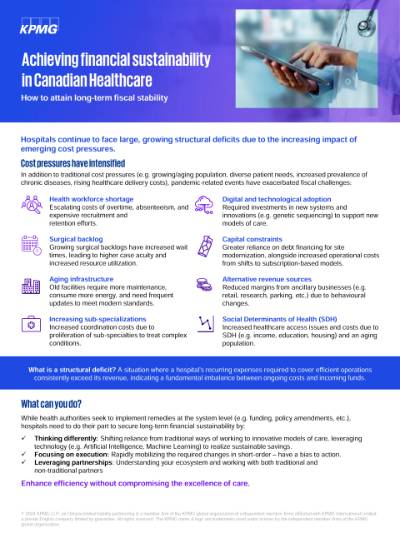Hospitals continue to face large, growing structural deficits due to the increasing impact of emerging cost pressures. In the face of growing financial challenges, Canadian hospitals must adopt innovative strategies to secure long-term financial sustainability. In this report we outline key insights and approaches to achieve financial sustainability in Canadian healthcare institutions.
Cost pressures have intensified
In addition to traditional cost pressures (e.g. growing/aging population, diverse patient needs, increased prevalence of chronic diseases, rising healthcare delivery costs), pandemic-related events have exacerbated fiscal challenges:

Escalating costs of overtime, absenteeism, and expensive recruitment and retention efforts.
Empower and inform your teams and stakeholders with full access to data visualization tools and insights

Old facilities require more maintenance, consume more energy, and need frequent updates to meet modern standards.

Increased coordination costs due to proliferation of sub-specialties to treat complex conditions.

Required investments in new systems and innovations (e.g. genetic sequencing) to support new models of care.

Greater reliance on debt financing for site modernization, alongside increased operational costs from shifts to subscription-based models.

Reduced margins from ancillary businesses (e.g. retail, research, parking, etc.) due to behavioural changes.

Increased healthcare access issues and costs due to SDH (e.g. income, education, housing) and an aging population.
A situation where a hospital's recurring expenses required to cover efficient operations consistently exceed its revenue, indicating a fundamental imbalance between ongoing costs and incoming funds.
What can you do?
While health authorities seek to implement remedies at the system level (e.g. funding, policy amendments, etc.), hospitals need to do their part to secure long-term financial sustainability by:
- Thinking differently: Shifting reliance from traditional ways of working to innovative models of care, leveraging technology (e.g. Artificial Intelligence, Machine Learning) to realize sustainable savings.
- Focusing on execution: Rapidly mobilizing the required changes in short-order – have a bias to action.
- Leveraging partnerships: Understanding your ecosystem and working with both traditional and non-traditional partners
Enhance efficiency without compromising the excellence of care.
Six levers to achieve financial sustainability
When looking to unlock savings our team recommends an approach focused on six levers.
| Key goals | Hospital/Local solution |
|---|---|
| Clinical operations Drive efficient and effective care delivery |
|
| Back-office and service optimization Optimize back-office services across hospital sites |
|
| Workforce Better forecast healthcare staffing needs |
|
| Automation and digital adoption Streamline manual processes and boost digital usage |
|
| Capital Effectively budget and finance the increasing costs of property, plant, and equipment |
|
| Integration of care Reduce system costs, maintain clinical outcomes, and ensure complete integration of all data and information |
|
How our team can help
Advanced data-driven diagnostics
- Identify local and systemic pressures to understand structural deficits' root causes
- Assess population health service needs and their funding implications
- Work with stakeholders to understand data quality, anomalies, and financial results interpretation
Practical application
- Realize and re-invest immediate savings and plan for future needs with viable short and long-term gains
- Identify tried-and-true innovations to implement and scale based on your unique circumstances
- Facilitate change management from leadership to your frontline to ensure successful adoption
Sustainable by design
- Utilize innovations like predictive analytics and AI for sustained financial performance
- Design and implement governance structures and incentives to foster accountability and transparency
- Build internal capacity and capability for long-term financial improvement
Call to action
To learn more about how your hospital can implement these strategies for financial sustainability, download the document "Achieving financial sustainability in Canadian healthcare."
Connect with us
For further inquiries or assistance, please contact:
Govind Adaikappan
Director, Healthcare Solutions
T: 416 777 3232
E: gadaikappan@kpmg.ca
Stay up to date with what matters to you
Gain access to personalized content based on your interests by signing up today
Connect with us
- Find office locations kpmg.findOfficeLocations
- kpmg.emailUs
- Social media @ KPMG kpmg.socialMedia


